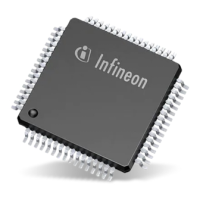Introduction to Digital Power Conversion
XMC4000/1000 Family
Application Software
Application Guide 88 V1.0, 2015-01
8 Application Software
Application software that focuses on for example the following topic areas, for the essential final
system properties, can be easily added to the main control tasks of the power transfer:
Advanced Algorithms / /User software SW IP for the Power Conversion
Multi-stage Control
Safety
Communication
Data Logging, Firmware Update
HMI (display-buttons)
Misc add-on software (for instance Feed-Forward Control, Non-Linearity compensation)
8.1 Advanced Algorithms / User software IP for Power Conversion
To this category belong add-on software such as SMPS Mode, Load Sharing, MPPT (Maximum
Power Point Tracking), Soft-start and Adaptive Characteristics control.
Load Sharing
Load Sharing means handling parallel supplies that are connected to the same load object. For
example, if one of the supplies has to be removed, the software will control the correct procedure for
shutting down this device before it is removed and, in an opposite case, it executes the correct
procedure to put it in.
MPPT
Maximum Power Point Tracking (MPPT) is a technique to get the maximum possible power from
energy sources (for example Solar cells) that produce non-linear output efficiency. By being able to
track the V-I output characteristic of the source, the power converter with MPPT can adjust the
operating point to maximum efficiency in realtime.
Soft start
In rush current control by increasing reference during start up / mixed current conduction mode or
burst mode control.
Adaptive Characteristics
Gain control in run time (depending on for example source/load/temperature/aging), change of dead-
times or PI, Type-II, Type-III parameters among others.
8.2 Multi-stage, multi-functional, multi-tasking control by a single controller
Several power conversion stages can be controlled by one XMC device, since it is equipped with a
number of sense-modulate-and-drive combination alternatives from available VADC, Analog
Comparator and CCU channels. Multi-tasking software, running on a mutual CPU, will assure correct
multi-functionallity in realtime.
Example: Second, third, fourth stages of SMPS for optimal PFC performance, EMC quality, efficiency
and voltage conversion adaption for distribution of several DC supplies – including Motor Control
capability (option).

